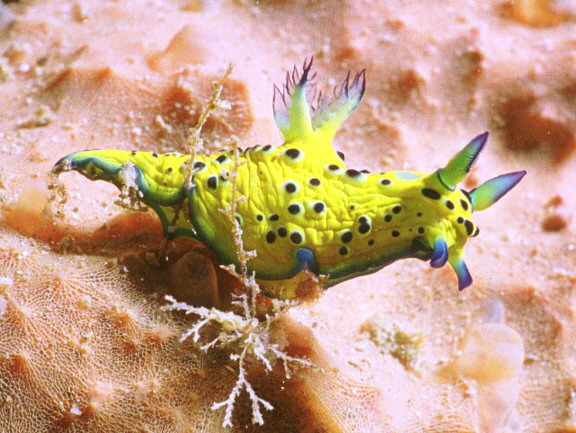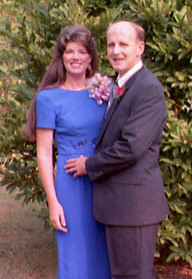 |
Roboastra something or another (author(s) & date, to be determined)...
So what the heck is this? Pretty neat, but no one seems to know what it is. You know, when us BIG SHOT experts see one like this, it makes us wonder how many others we've missed. Just goes to show you, your camera can find critters just as exciting as the ones we, occasionally, by a stroke of luck, find too.
Okay, so who is this little cutie? Well it's pretty clear it's a dorid - posterior dorsal gill plume. Long-slender body, non-retractile gill and rhinophores, rounded head, certainly suggest phanerobranch dorid, a nembrothid, infact, but that's where things get a little complicated.
You see, this group of nudibranchs have undergone quite a bit of taxonomic smoke and mirrors, at least among the three most closely related genera, Nembrotha, Tambja and Roboastra. Here's the deal - there are probably three or so dozen species worldwide, all strikingly colorful, all similar in external morphology, only differences in color, suggest that there may be other "hidden" differences elsewhere.
In the absence of a preserved specimen or two, to lay a sharp scalpel and forceps on, we are calling the beasty a Roboastra. This call is primarily because of the well developed oral tentacles, seen in the photo above, as the pair of dorso-laterally grooved cylindrical projections below and equal in the length to the rhinophores. As its color is certainly different from anything documented in the literature we can only guess what's going on internally. Roboastra, differs from its other closely related buddies by differences in the radula and reproductive system. Roboastra is distinct in having a rachidian tooth which has three long prongs or denticles, a lateral tooth that is long, bifid and whip like, and only 1-3 marginal teeth.
So that's about it. Keep your eyes open, your cameras armed and your
collection bottle ready, for the next time you swim over this cutie. Maybe
someday this Roboastra will be named Roboastra (insert your name here).
Photograph courtesy of Carol and Bob Cox, Florida

|
Carol and Bob Cox have lived in Fort Walton Beach, Florida for five years. In their spare time, they enjoy diving the Gulf of Mexico along the Florida Panhandle from their 24' Searay. Carol is an amateur underwater photographer, while her husband enjoys underwater video, spearfishing, and lobster hunting. Robert is a PADI certified instructor, and both Carol and Bob are volunteer members of the Okaloosa County Sheriff's Department Underwater Investigation Unit. Carol became interested in nudibranch photography when she acquired a 1:2 macro lens a year ago. While searching the web for clues to the identities of her nudibranch pictures, Carol found "The Slug Site". She realized there was very little documentation on Gulf of Mexico nudibranchs and contacted Mike Miller with her pictures. Along with locating weight belts and camera lenses dropped in 110 feet of murky Gulf waters, Bob is an expert at finding the unusual under the Gulf waters. On the first day Carol used her 1:2 macro lens she asked Bob to find her a nudibranch; he found the yellow and blue nudibranch that has yet to be identified. |
Bob and Carol hope to retire in 7 years, buy a sailboat, and cruise the tropics in search of new diving adventures.
Send Carol e- mail at ccox@mchsi.com
Taxonomic information courtesy of:

David W. Behrens
Author:
Pacific Coast Nudibranchs
Send Dave mail at seachalleng@earthlink.net
|
